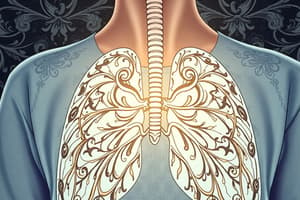Podcast
Questions and Answers
A nurse is caring for a patient with a chest tube inserted for a pneumothorax. Where should the nurse expect the chest tube to be primarily directed?
A nurse is caring for a patient with a chest tube inserted for a pneumothorax. Where should the nurse expect the chest tube to be primarily directed?
- Inferiorly towards the base of the lung
- Medially towards the mediastinum
- Posteriorly and lateral to the nipple line
- Anteriorly and superiorly towards the apex of the lung (correct)
A patient with a hemothorax has a chest tube inserted. Which chest tube placement would best facilitate drainage of blood from the pleural space?
A patient with a hemothorax has a chest tube inserted. Which chest tube placement would best facilitate drainage of blood from the pleural space?
- Posterior and inferior placement (correct)
- High anterior placement
- Mid-axillary at the fourth intercostal space
- Subclavicular placement
The water-seal chamber of a chest drainage unit is essential for preventing backflow. What is the primary mechanism by which the water-seal chamber achieves this?
The water-seal chamber of a chest drainage unit is essential for preventing backflow. What is the primary mechanism by which the water-seal chamber achieves this?
- Gravity-dependent drainage into the collection chamber
- Positive pressure maintained within the system
- Negative pressure generated by wall suction
- A one-way valve created by the water column (correct)
During assessment of a patient with a chest tube, the nurse observes fluctuations of the water column in the water-seal chamber with respiration. This finding, known as tidaling, indicates:
During assessment of a patient with a chest tube, the nurse observes fluctuations of the water column in the water-seal chamber with respiration. This finding, known as tidaling, indicates:
A nurse notes continuous bubbling in the water-seal chamber of a chest drainage system. What is the most likely cause of this finding?
A nurse notes continuous bubbling in the water-seal chamber of a chest drainage system. What is the most likely cause of this finding?
The suction control chamber of a wet chest drainage system regulates the amount of negative pressure applied to the pleural space. How is the suction pressure determined in a wet suction system?
The suction control chamber of a wet chest drainage system regulates the amount of negative pressure applied to the pleural space. How is the suction pressure determined in a wet suction system?
A patient with a chest tube suddenly stops having drainage, and tidaling in the water-seal chamber has ceased. What is the priority nursing intervention?
A patient with a chest tube suddenly stops having drainage, and tidaling in the water-seal chamber has ceased. What is the priority nursing intervention?
When changing the dressing at a chest tube insertion site, what key assessment finding should the nurse immediately report to the physician?
When changing the dressing at a chest tube insertion site, what key assessment finding should the nurse immediately report to the physician?
A nurse is educating a patient with a chest tube on activities to promote lung re-expansion. Which instruction is most appropriate?
A nurse is educating a patient with a chest tube on activities to promote lung re-expansion. Which instruction is most appropriate?
What is the primary purpose of attaching a chest tube to a chest drainage unit (CDU)?
What is the primary purpose of attaching a chest tube to a chest drainage unit (CDU)?
A patient with a chest tube is being transported to radiology for a chest X-ray. Which action is essential for the nurse to take during transport to maintain the integrity of the chest tube system?
A patient with a chest tube is being transported to radiology for a chest X-ray. Which action is essential for the nurse to take during transport to maintain the integrity of the chest tube system?
The collection chamber of a chest drainage unit serves what primary function?
The collection chamber of a chest drainage unit serves what primary function?
In a dry suction chest drainage system, how is the suction pressure regulated?
In a dry suction chest drainage system, how is the suction pressure regulated?
A nurse is assessing a patient with a chest tube and observes that the drainage has changed from sanguineous to serosanguineous. What is the most appropriate nursing action based on this finding?
A nurse is assessing a patient with a chest tube and observes that the drainage has changed from sanguineous to serosanguineous. What is the most appropriate nursing action based on this finding?
What is the recommended wall suction setting range when using a chest drainage system?
What is the recommended wall suction setting range when using a chest drainage system?
When should a chest drainage unit (CDU) be changed?
When should a chest drainage unit (CDU) be changed?
After chest tube removal, what type of dressing is typically applied to the insertion site?
After chest tube removal, what type of dressing is typically applied to the insertion site?
A nurse is monitoring a patient with a chest tube. Which finding requires immediate intervention?
A nurse is monitoring a patient with a chest tube. Which finding requires immediate intervention?
What is the purpose of suturing a chest tube in place after insertion?
What is the purpose of suturing a chest tube in place after insertion?
Which of the following is NOT a typical indication for chest tube insertion?
Which of the following is NOT a typical indication for chest tube insertion?
Flashcards
Chest Tube
Chest Tube
Thin tubes inserted into the pleural cavity to remove excess fluid or air, restoring lung function.
Pleural Cavity
Pleural Cavity
The space between the visceral and parietal pleura where chest tubes are inserted.
Pleurodesis
Pleurodesis
To treat recurrent pleural effusions by instilling chemotherapeutic drugs or sclerosing agents.
Pneumothorax Chest Tube Placement
Pneumothorax Chest Tube Placement
Signup and view all the flashcards
Hemothorax Chest Tube Placement
Hemothorax Chest Tube Placement
Signup and view all the flashcards
Chest Drainage Unit (CDU)
Chest Drainage Unit (CDU)
Signup and view all the flashcards
Collection Chamber (CDU)
Collection Chamber (CDU)
Signup and view all the flashcards
Water-Seal Chamber (CDU)
Water-Seal Chamber (CDU)
Signup and view all the flashcards
Tidaling
Tidaling
Signup and view all the flashcards
Suction Control Chamber (CDU)
Suction Control Chamber (CDU)
Signup and view all the flashcards
Chest Tube Monitoring
Chest Tube Monitoring
Signup and view all the flashcards
Chest Tube Insertion Site
Chest Tube Insertion Site
Signup and view all the flashcards
Chest Drainage Unit (CDU) Maintenance
Chest Drainage Unit (CDU) Maintenance
Signup and view all the flashcards
Patient Education (Chest Tube)
Patient Education (Chest Tube)
Signup and view all the flashcards
Subcutaneous Emphysema
Subcutaneous Emphysema
Signup and view all the flashcards
Study Notes
- Chest tubes are thin tubes inserted into the pleural cavity.
- Pleural cavity: Space between visceral and parietal pleura.
- Chest tubes are also known as pleural catheters.
- Chest tube restores lung function by removing excess fluid or air.
- Chest tubes are used to instill chemotherapeutic drugs or sclerosing agents to treat recurrent pleural effusions (pleurodesis).
- Chest tubes can be used prophylactically after thoracic or cardiac surgery to prevent fluid accumulation.
- Chest tubes are placed either percutaneously or surgically.
Placement
- For pneumothorax, the tube is directed high and anterior.
- For hemothorax, the tube is directed posteriorly and lateral to the nipple line.
- The Chest tube is sutured in place.
- The insertion site is covered with an occlusive petroleum gauze dressing.
- It is attached to a chest drainage unit (CDU).
Chest Drainage Unit (CDU)
- CDUs restore normal intrapleural pressure.
- CDUs facilitate drainage of air and fluid.
- CDUs prevent backflow of air.
- CDUs are categorized by the number of chambers and mechanisms preventing air entry.
- Three-chamber systems are widely used.
CDU Chambers
- Collection chamber: Collects drained fluids, allowing monitoring of characteristics and quantity.
- Water-seal chamber: Acts as a one-way valve, allowing drainage of air and fluid, and preventing air entry.
- The chamber is filled with sterile water.
- Water oscillates with breathing (tidaling), reflecting normal pressure.
- Suction control chamber: Regulates the amount of negative pressure generated.
- "Wet Systems": Suction pressure is regulated by water column height.
- "Dry Systems": Use a regulator and suction monitor bellows.
- Suction pressure is commonly set at negative 20 cm of water.
Nursing Interventions
- Ongoing assessments are needed, and nurses need core clinical knowledge
- Follow facility policies including CDU recommendations
- Practice hand hygiene and aseptic technique.
- Report new or significant changes in patient condition.
Nursing Interventions - Monitoring
- Frequency per facility policy:
- Vital signs.
- Respiratory status: skin color, respiratory depth/rhythm, accessory muscle use, O2 saturation, breath sounds.
- Pain level.
- Insertion site dressing: dry, intact, occlusive, subcutaneous emphysema signs.
- Drainage and suction tubing: kinks, bends, dependent loops, loose connections, air leaks, patency.
- Wall suction: generally set at 80-120 mmHg.
- Correct CDU positioning.
- Presence of emergency equipment.
Nursing Interventions - Ongoing Care
- Change insertion site dressing:
- Per physician’s orders.
- Assess insertion site: infection, displaced tube, subcutaneous emphysema.
- Change CDU when full or not functioning.
- Educate the patient on frequent position changes, coughing, and deep breathing.
Studying That Suits You
Use AI to generate personalized quizzes and flashcards to suit your learning preferences.






